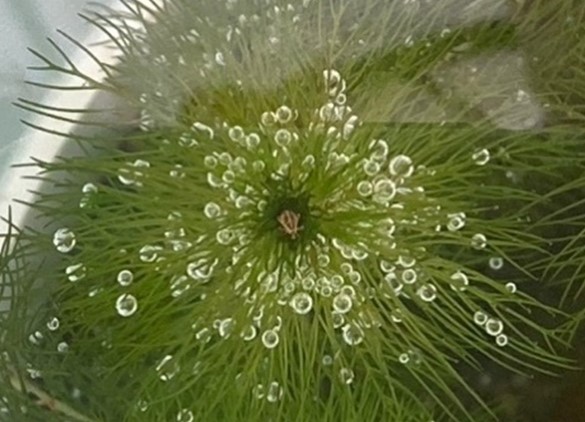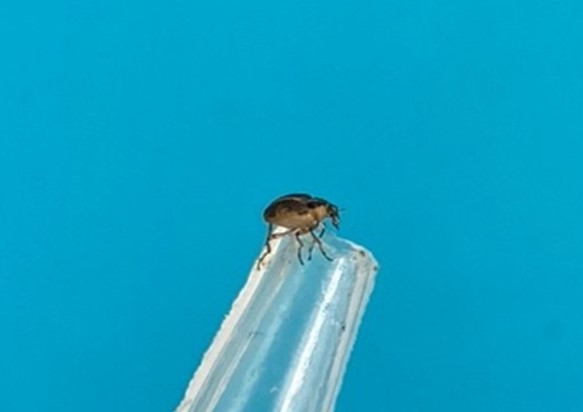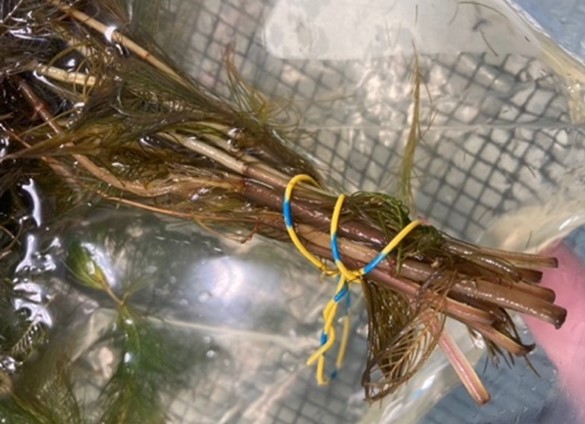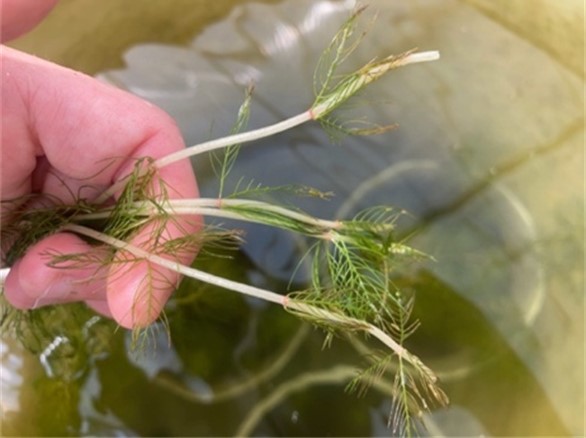Milfoil Weevil (Euhrychiopsis lecontei)
By Hannah Hoff, MSU Dept. of Plant Sciences and Plant Pathology, Email Hannah Hoff
Background

Adult weevil on watermilfoil meristem. Photo by Hannah Hoff.
The milfoil weevil (Euhrychiopsis lecontei) is a small aquatic beetle native to North America that is a specialist herbivore of the native northern watermilfoil (Myriophyllum sibiricum) and Eurasian watermilfoil (M. spicatum). It spends much of its life submerged, mining into watermilfoil stems to feed and develop. Specialist herbivores are rare among aquatic insects, and native insects are appealing for biological control due to reduced risks to non-target species. Therefore, the milfoil weevilhas been an appealing agent for Eurasian and hybrid (M. spicatum × sibiricum) watermilfoil.
Identification

Adult weevil on pipette tip. Photo by Hannah Hoff.
Adult milfoil weevils are very small (~2-3 mm long), so locating them is difficult. Damage to a watermilfoil patch is often the best way to initially locate weevil populations. Adults are typically found in the top three feet of a submerged (nonflowering) watermilfoil stem. They are brown with yellow to brown stripes on their backs. Darkened and hollowed watermilfoil stems are characteristic of stem mining by larvae and pupae.
Biology

Hollowed milfoil stems from larval/pupal mining. Photo by Hannah Hoff.
Adult milfoil weevils spend winters in leaf litter on shore and migrate back to watermilfoil patches in spring. From there, adults feed on milfoil leaves and lay eggs on the apical meristems of plants. After hatching, larvae mine into stems and pupate in chambers near the base of plants. Larval and pupal life stages inflict the most significant damage, as destruction of stem tissue disrupts a plant’s ability to transport nutrients and reduces buoyancy. However, the potential to cause damage to invasive watermilfoil at each stage of its life cycle makes the weevil an appealing biological control agent.
Impacts
The milfoil weevil has undergone extensive study and has, in some cases, led to effective control. For example, numerous studies have

Healthy, un-mined milfoil meristems. Photo by Hannah Hoff.
documented weevils decreasing plant height and biomass in invasive watermilfoil; in one study, biomass was comparable to plants treated with the systemic herbicide fluridone. However, other studies have shown no significant impact on watermilfoil biomass, and field surveys generally have shown substantial variability in weevil efficacy.
Current Status
As a result of varying efficacy in their ability to decrease invasive watermilfoil populations, the use of milfoil weevilshas declined in recent years, with rearing operations permanently discontinued and some state agencies no longer providing funding for milfoil weevil research. Additional research, if pursued, should examine potential factors contributing to the weevil’s inconsistent efficacy in field trials.
Further Information
For more information about this month's weed post, contact Extension Invasive Plant Specialist Jane Mangold. Past posts are available in the Monthly Weed Post Directory.
This weed post is also available as a printable PDF (635KB).
